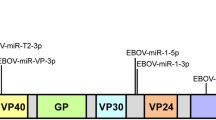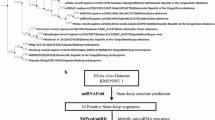Abstract
Ebola virus (EBOV), a member of the filovirus family, is an enveloped negative-sense RNA virus that causes lethal infections in humans and primates. Recently, more than 1000 people have been killed by the Ebola virus disease in Africa, yet no specific treatment or diagnostic tests for EBOV are available. In this study, we identified two putative viral microRNA precursors (pre-miRNAs) and three putative mature microRNAs (miRNAs) derived from the EBOV genome. The production of the EBOV miRNAs was further validated in HEK293T cells transfected with a pcDNA6.2-GW/EmGFP-EBOV-pre-miRNA plasmid, indicating that EBOV miRNAs can be produced through the cellular miRNA processing machinery. We also predicted the potential target genes of these EBOV miRNAs and their possible biological functions. Overall, this study reports for the first time that EBOV may produce miRNAs, which could serve as non-invasive biomarkers for the diagnosis and prognosis of EBOV infection and as therapeutic targets for Ebola viral infection treatment.
Article PDF
Similar content being viewed by others
Avoid common mistakes on your manuscript.
References
Feldmann H, Geisbert TW. Ebola haemorrhagic fever. Lancet, 2011, 377: 849–862
Frieden TR, Damon I, Bell BP, Kenyon T, Nichol S. Ebola 2014- new challenges, new global response and responsibility. N Engl J Med, 2014, doi: 10.1056/NEJMp1409903
Dixon MG, Schafer IJ. Ebola viral disease outbreak-West Africa, 2014. MMWR Morb Mortal Wkly Rep, 2014, 63: 548–551
Ebola: the virus and the disease. Wkly Epidemiol Rec, 1999, 74: 89
Turner C. Ebola virus disease: an emerging threat. Nursing, 2014, 44: 68–69
Bartel DP. MicroRNAs: genomics, biogenesis, mechanism, and function. Cell, 2004, 116: 281–297
Ambros V. The functions of animal microRNAs. Nature, 2004, 431: 350–355
He L, Hannon GJ. MicroRNAs: small RNAs with a big role in gene regulation. Nat Rev Genet, 2004, 5: 522–531
Cullen BR. Viruses and microRNAs. Nat Genet, 2006, 38(Suppl): S25–30
Grundhoff A, Sullivan CS. Virus-encoded microRNAs. Virology, 2011, 411: 325–343
Kincaid RP, Sullivan CS. Virus-encoded microRNAs: an overview and a look to the future. PLoS Pathog, 2012, 8: e1003018
Pfeffer S, Zavolan M, Grasser FA, Chien M, Russo JJ, Ju J, John B, Enright AJ, Marks D, Sander C, Tuschl T. Identification of virus-encoded microRNAs. Science, 2004, 304: 734–736
Cai X, Lu S, Zhang Z, Gonzalez CM, Damania B, Cullen BR. Kaposi’s sarcoma-associated herpesvirus expresses an array of viral microRNAs in latently infected cells. Proc Natl Acad Sci USA, 2005, 102: 5570–5575
Samols MA, Hu J, Skalsky RL, Renne R. Cloning and identification of a microRNA cluster within the latency-associated region of kaposi’s sarcoma-associated herpesvirus. J Virol, 2005, 79: 9301–9305
Pfeffer S, Sewer A, Lagos-Quintana M, Sheridan R, Sander C, Grasser FA, van Dyk LF, Ho CK, Shuman S, Chien M, Russo JJ, Ju J, Randall G, Lindenbach BD, Rice CM, Simon V, Ho DD, Zavolan M, Tuschl T. Identification of microRNAs of the herpesvirus family. Nat Methods, 2005, 2: 269–276
Sullivan CS, Grundhoff AT, Tevethia S, Pipas JM, Ganem D. SV40-encoded microRNAs regulate viral gene expression and reduce susceptibility to cytotoxic T cells. Nature, 2005, 435: 682–686
Cui C, Griffiths A, Li G, Silva LM, Kramer MF, Gaasterland T, Wang XJ, Coen DM. Prediction and identification of herpes simplex virus 1-encoded microRNAs. J Virol, 2006, 80: 5499–5508
Griffiths-Jones S. The microRNA registry. Nucleic Acids Res, 2004, 32: D109–111
Griffiths-Jones S, Grocock RJ, van Dongen S, Bateman A, Enright AJ. MiRBase: microRNA sequences, targets and gene nomenclature. Nucleic Acids Res, 2006, 34: D140–144
Shi JD, Duan ZQ, Sun J, Wu MN, Wang B, Zhang J, Wang HX, Hu NZ, Hu YZ. Identification and validation of a novel microRNA-like molecule derived from a cytoplasmic RNA virus antigenome by bioinformatics and experimental approaches. Virol J, 2014, 11: 121
Rouha H, Thurner C, Mandl CW. Functional microRNA generated from a cytoplasmic RNA virus. Nucleic Acids Res, 2010, 38: 8328–8337
Varble A, Chua MA, Perez JT, Manicassamy B, Garcia-Sastre A, tenOever BR. Engineered RNA viral synthesis of microRNAs. Proc Natl Acad Sci USA, 2010, 107: 11519–11524
Shapiro JS, Varble A, Pham AM, Tenoever BR. Noncanonical cytoplasmic processing of viral microRNAs. RNA, 2010, 16: 2068–2074
Varble A, ten Oever BR. Implications of RNA virus-produced miRNAs. RNA Biol, 2011, 8: 190–194
Usme-Ciro JA, Campillo-Pedroza N, Almazan F, Gallego-Gomez JC. Cytoplasmic RNA viruses as potential vehicles for the delivery of therapeutic small RNAs. Virol J, 2013, 10: 185
Zhang Y, Fan M, Geng G, Liu B, Huang Z, Luo H, Zhou J, Guo X, Cai W, Zhang H. A novel HIV-1-encoded microRNA enhances its viral replication by targeting the TATA box region. Retrovirology, 2014, 11: 23
Kaul D, Ahlawat A, Gupta SD. HIV-1 genome-encoded hiv1-mir-H1 impairs cellular responses to infection. Mol Cell Biochem, 2009, 323: 143–148
Kincaid RP, Burke JM, Sullivan CS. RNA virus microRNA that mimics a B-cell oncomiR. Proc Natl Acad Sci USA, 2012, 109: 3077–3082
Rosewick N, Momont M, Durkin K, Takeda H, Caiment F, Cleuter Y, Vernin C, Mortreux F, Wattel E, Burny A, Georges M, van den Broeke A. Deep sequencing reveals abundant noncanonical retroviral microRNAs in B-cell leukemia/lymphoma. Proc Natl Acad Sci USA, 2013, 110: 2306–2311
Hussain M, Torres S, Schnettler E, Funk A, Grundhoff A, Pijlman GP, Khromykh AA, Asgari S. West Nile virus encodes a microRNA-like small RNA in the 3′ untranslated region which up-regulates GATA4 mRNA and facilitates virus replication in mosquito cells. Nucleic Acids Res, 2012, 40: 2210–2223
Hussain M, Asgari S. MicroRNA-like viral small RNA from dengue virus 2 autoregulates its replication in mosquito cells. Proc Natl Acad Sci USA, 2014, 111: 2746–2751
Li SC, Shiau CK, Lin WC. Vir-Mir db: prediction of viral microrna candidate hairpins. Nucleic Acids Res, 2008, 36: D184–189
Jiang P, Wu H, Wang W, Ma W, Sun X, Lu Z. MiPred: classification of real and pseudo microRNA precursors using random forest prediction model with combined features. Nucleic Acids Res, 2007, 35: W339–344
Gkirtzou K, Tsamardinos I, Tsakalides P, Poirazi P. MatureBayes: a probabilistic algorithm for identifying the mature miRNA within novel precursors. PLoS One, 2010, 5: e11843
Bayes-SVM-MiRNA web server v1.0. http://wotan.Wistar.Upenn.Edu/bayessvmmirnafind/
Seo GJ, Chen CJ, Sullivan CS. Merkel cell polyomavirus encodes a microRNA with the ability to autoregulate viral gene expression. Virology, 2009, 383: 183–187
Lewis BP, Shih IH, Jones-Rhoades MW, Bartel DP, Burge CB. Prediction of mammalian microRNA targets. Cell, 2003, 115: 787–798
Rehmsmeier M, Steffen P, Hochsmann M, Giegerich R. Fast and effective prediction of microRNA/target duplexes. RNA, 2004, 10: 1507–1517
Berezikov E, Cuppen E, Plasterk RH. Approaches to microRNA discovery. Nat Genet, 2006, 38(Suppl): S2–7
Singh J, Singh CP, Bhavani A, Nagaraju J. Discovering microRNAs from Bombyx mori nucleopolyhedrosis virus. Virology, 2010, 407: 120–128
Hussain M, Taft RJ, Asgari S. An insect virus-encoded microRNA regulates viral replication. J Virol, 2008, 82: 9164–9170
Besecker MI, Harden ME, Li G, Wang XJ, Griffiths A. Discovery of herpes B virus-encoded microRNAs. J Virol, 2009, 83: 3413–3416
Wong G, Kobinger GP, Qiu X. Characterization of host immune responses in Ebola virus infections. Expert Rev Clin Immunol, 2014, 10: 781–790
Author information
Authors and Affiliations
Corresponding authors
Additional information
Contributed equally to this work
This article is published with open access at link.springer.com
Electronic supplementary material
Rights and permissions
Open Access This article is distributed under the terms of the Creative Commons Attribution 4.0 International License (https://creativecommons.org/licenses/by/4.0), which permits use, duplication, adaptation, distribution, and reproduction in any medium or format, as long as you give appropriate credit to the original author(s) and the source, provide a link to the Creative Commons license, and indicate if changes were made.
About this article
Cite this article
Liang, H., Zhou, Z., Zhang, S. et al. Identification of Ebola virus microRNAs and their putative pathological function. Sci. China Life Sci. 57, 973–981 (2014). https://doi.org/10.1007/s11427-014-4759-2
Received:
Accepted:
Published:
Issue Date:
DOI: https://doi.org/10.1007/s11427-014-4759-2




